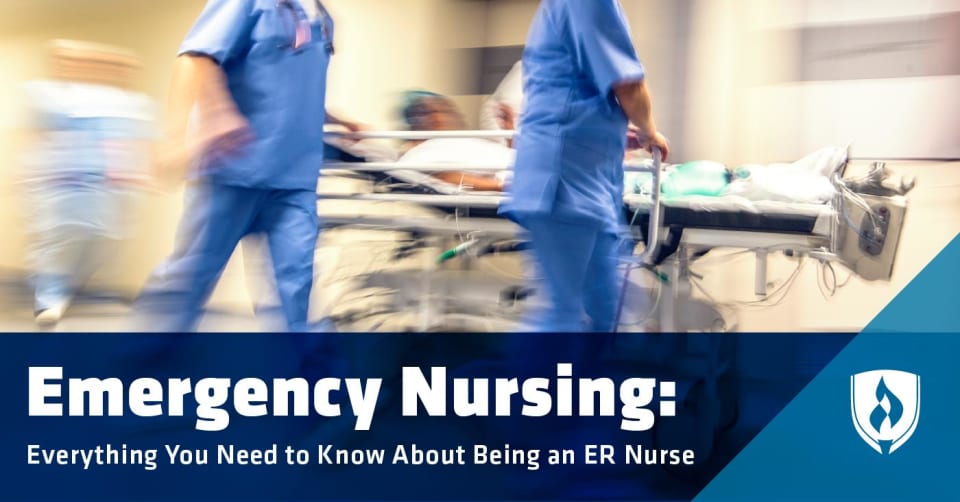Emergency Nursing: Everything You Need to Know About Being an ER Nurse
By Ashley Brooks on 09/04/2018

If you have hopes of pursuing a career in nursing, you’ve probably looked into the different specialties available to nurses. Each specialty demands its own skills and characteristics, which is especially true for those working in emergency nursing. Emergency nurses work in a fast-paced, often-stressful environment that requires a unique skill set above and beyond the standard nursing skills.
Your ability to stay calm and collected in urgent situations is one of the reasons you’re considering becoming an emergency room nurse. But the thought of working in the ER is intimidating—what if you can’t handle the pressure? Or is that part of the job overblown? You need all the info you can get as you research the ins and outs of emergency nursing. Keep reading to learn more about the skills and qualities you’ll need in this dynamic nursing specialty.
Get Your Nursing School Questions Answered at a Nursing Information Session
What do emergency nurses do?
ER nurses treat patients who are suffering from trauma, injury or severe medical conditions and require urgent treatment. Since these specialists work in crisis situations, they must be able to quickly identify the best way to stabilize patients and minimize pain.
“The nursing duties are the same wherever you work—except in the emergency department, everything is compressed,” says former trauma and transport nurse Pat Carroll. She shares that ER nurses are often evaluating and treating patients almost simultaneously, and they work with a team of specialists, such as radiologists and orthopedic experts, to provide the highest-quality care.
Working in an emergency room isn’t all excitement all the time. “Every shift is not as exciting as a shift on TV,” Carroll says. “The interesting and unusual cases they treat in one day may happen over a month or two in a typical emergency department.” Lauren Elliott, author and RN, adds that, depending on the hospital, ER nurses can spend much of their time performing other duties like preparing rooms and updating electronic health records.
Emergency nursing careers may also come with the important role of educating the public. Some ER nurses participate in public programs that promote wellness and prevent injuries, such as alcohol awareness, child passenger safety, gun safety, bicycle and helmet safety and domestic violence prevention.
What are the most common conditions treated in the ER?
Emergency nurses encounter many conditions with varying degrees of severity—ailments range anywhere from a sore throat to a heart attack. According to data from the Agency for Healthcare Research and Quality Healthcare Cost and Utilization Project, the top-five reasons for ER visits in 2014 were*:
- Abdominal pain
- Upper-respiratory infections
- Strains and sprains
- Superficial injury (an injury that does not affect muscles or organs)
- Chest pain
The injuries ER nurses encounter most often depends largely on where they work. Hospitals in large metropolitan areas are more likely to see extreme cases like gunshot or stab wounds, but they also receive patients with less-acute problems who are simply seeking primary care, according to Carroll.
Rural areas typically have more trauma injuries resulting from vehicle crashes or accidents with farm equipment. “And, today, everybody is seeing significantly more overdoses regardless of where we practice,” Carroll adds.
Geographic region also plays a role. Elliott notes that emergency departments in southern states are more likely to see illnesses that affect the elderly, such as chest pain or fractures from falls, since many “snowbirds” head for warmer climates to escape harsh winters in their home states.
Where do emergency nurses work?
The majority of emergency nurses work in the emergency departments of hospitals or medical clinics, but there are a few other work environments you may not have guessed for this nursing specialty.
Emergency nurses can be found working as “Flight nurses, on search and rescue teams, in the film industry as movie medics or in urgent care facilities,” Elliott says. If the prospect of practicing your medical skills in the air or on the set of a Hollywood movie isn’t exciting enough, ER nurses can also serve patients by working on cruise ships. Emergency nurses are particularly well suited for this unique work environment since they’re used to seeing patients with a variety of ailments, according to Carroll.
There are also calmer options for emergency nurses, such as schools or walk-in clinics, where their emergency skills can serve a vital role. “We are particularly valuable if we have emergency department experience and can pick out that one person with symptoms that seem appropriate for a walk-in center but are, in fact, more serious,” Carroll says.
Nurses who specialize in emergency situations are limited only by their own preferences when it comes to choosing a work environment. “I think we could work virtually anywhere,” Elliott says. “ER nurses see and deal with everything.”
What are the qualities of a successful emergency nurse?
There’s not one set of necessary qualities that’s required if you want to be an ER nurse, but having certain characteristics might make you more suited for the job.
Emergency nurses must be able to remain calm in high-stress and high-pressure situations, and that includes exuding confidence in the midst of uncertainty, Carroll says. Your ability to handle a situation with care and confidence can make a big difference in a patient’s level of comfort and calm.
Staying flexible in tricky situations is essential, according to Elliott. “You must be able to deal with situations that have no warning and be able to roll with whatever happens.” Having a thirst for knowledge is another trait that will serve you well in the ER. “You need to be committed to lifelong learning, because you can see anything in the emergency department. You need to keep up with everything,” Carroll says.
In the end, one of the most important qualities an ER nurse can have is one that’s shared across all nursing specialties: empathy. “There is nothing worse than being in need of emergency services and having no one who smiles, understands you or remembers you don't want to be there,” Elliott says. “I believe one must be compassionate, patient and unafraid to be human.”
How do you become an emergency nurse?
The first step is simple: you must become a registered nurse (RN) by obtaining either an Associate’s Degree in Nursing (ADN) or Bachelor of Science in Nursing (BSN). Both roads lead to an RN career, but you’ll have to decide whether an ADN or a BSN is best for your own career aspirations. Once you have your Nursing degree in hand, you’ll have to pass the National Council Licensure Examination (NCLEX-RN) before working as a registered nurse.
After becoming a fully licensed RN, you can begin working toward a specialty in emergency nursing. Gaining experience in emergency medical situations will be key. Try working as a floating nurse in your hospital’s emergency room or assisting teams of paramedics to acquire applicable experience.
After earning a minimum of two years of related emergency experience, you can also apply to earn a certification from the Board of Certification for Emergency Nursing (BCEN). This credential isn’t required to land employment as an emergency nurse, but it could give you an edge on other candidates.
Save the day as an emergency nurse
Does the idea of thinking on your feet in the fast-paced environment of the emergency room get your adrenaline pumping? Then emergency nursing might be the perfect nursing specialty for you.
Before you can conquer the chaos of the emergency room, you must first become a licensed RN. Learn how to get started in our article, “How to Become a Registered Nurse (Your Step-by-Step Guide).”
* Brian J. Moore, Ph.D., Carol Stocks, Ph.D., R.N., and Pamela L. Owens, Ph.D., Trends in Emergency Department Visits, 2006-2014, Healthcare Cost and Utilization Project.




